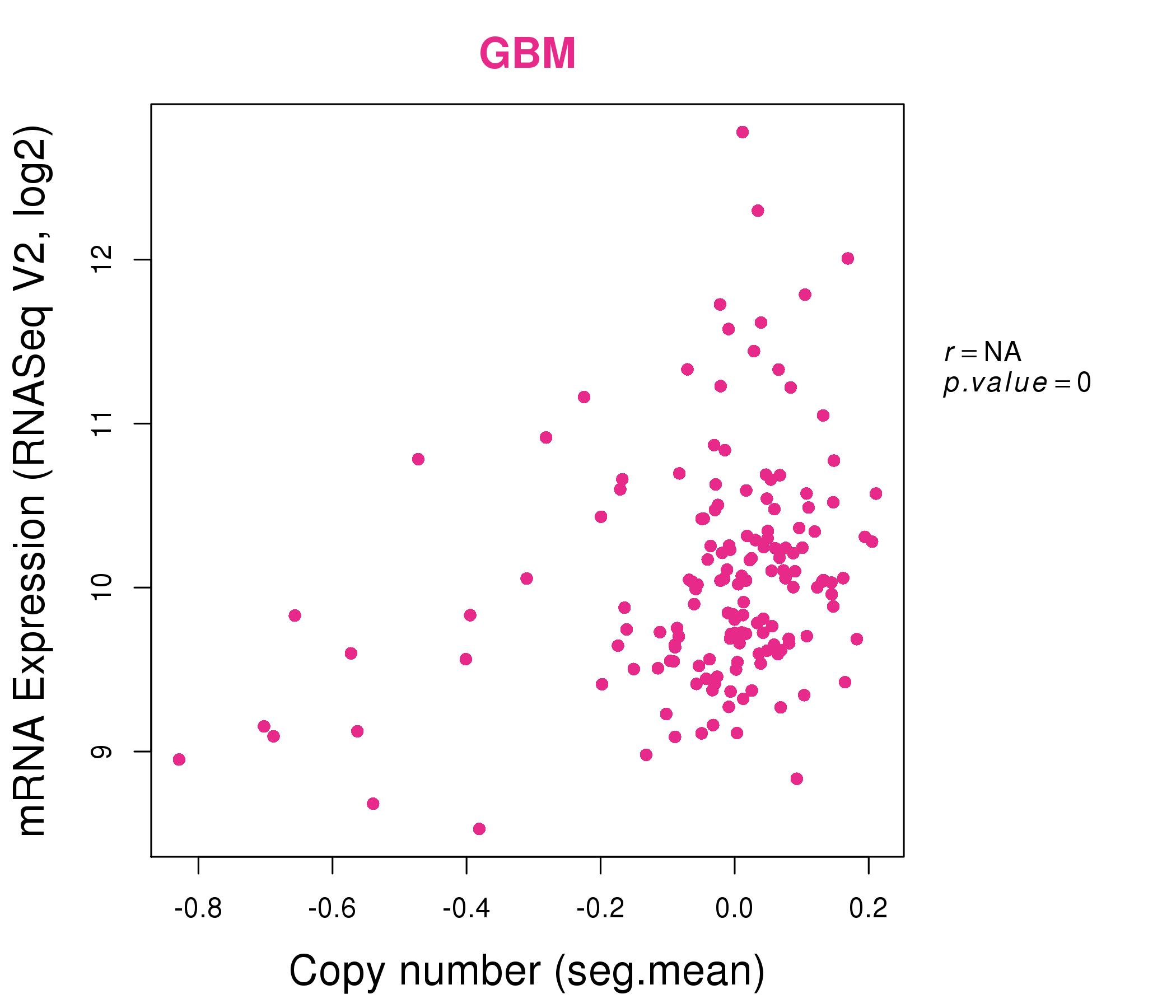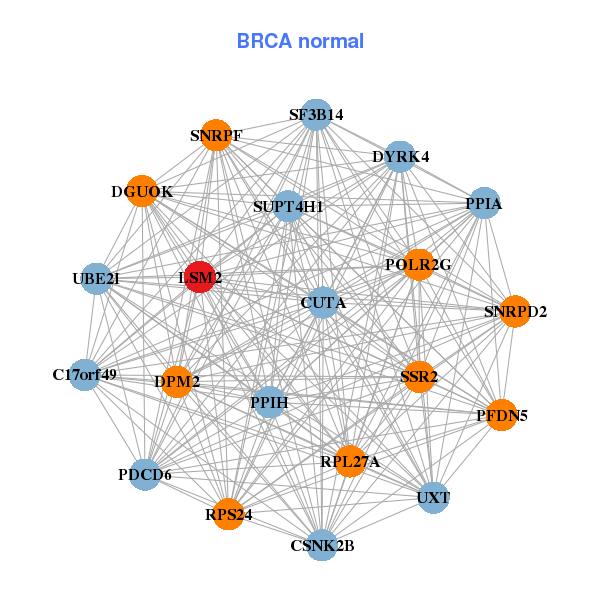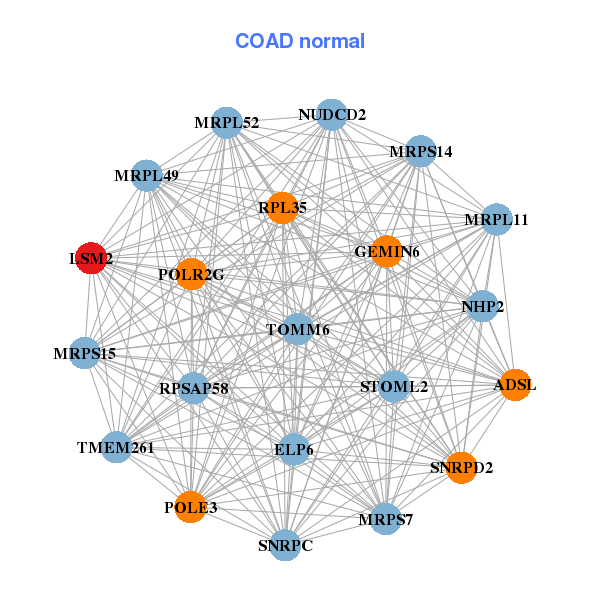|
||||||||||||||||||||
| |
| Phenotypic Information (metabolism pathway, cancer, disease, phenome) |
| |
| |
| Gene-Gene Network Information: Co-Expression Network, Interacting Genes & KEGG |
| |
|
| Gene Summary for LSM2 |
| Basic gene info. | Gene symbol | LSM2 |
| Gene name | LSM2 homolog, U6 small nuclear RNA associated (S. cerevisiae) | |
| Synonyms | C6orf28|G7B|YBL026W|snRNP | |
| Cytomap | UCSC genome browser: 6p21.3 | |
| Genomic location | chr6_mcf_hap5 :3144865-3154459 | |
| Type of gene | protein-coding | |
| RefGenes | NM_021177.4, | |
| Ensembl id | ENSG00000204392 | |
| Description | U6 snRNA-associated Sm-like protein LSm2protein G7bsmall nuclear ribonuclear protein D homologsnRNP core Sm-like protein Sm-x5 | |
| Modification date | 20141207 | |
| dbXrefs | MIM : 607282 | |
| HGNC : HGNC | ||
| Ensembl : ENSG00000204392 | ||
| HPRD : 06282 | ||
| Vega : OTTHUMG00000031121 | ||
| Protein | UniProt: Q9Y333 go to UniProt's Cross Reference DB Table | |
| Expression | CleanEX: HS_LSM2 | |
| BioGPS: 57819 | ||
| Gene Expression Atlas: ENSG00000204392 | ||
| The Human Protein Atlas: ENSG00000204392 | ||
| Pathway | NCI Pathway Interaction Database: LSM2 | |
| KEGG: LSM2 | ||
| REACTOME: LSM2 | ||
| ConsensusPathDB | ||
| Pathway Commons: LSM2 | ||
| Metabolism | MetaCyc: LSM2 | |
| HUMANCyc: LSM2 | ||
| Regulation | Ensembl's Regulation: ENSG00000204392 | |
| miRBase: chr6_mcf_hap5 :3,144,865-3,154,459 | ||
| TargetScan: NM_021177 | ||
| cisRED: ENSG00000204392 | ||
| Context | iHOP: LSM2 | |
| cancer metabolism search in PubMed: LSM2 | ||
| UCL Cancer Institute: LSM2 | ||
| Assigned class in ccmGDB | B - This gene belongs to cancer gene. | |
| Top |
| Phenotypic Information for LSM2(metabolism pathway, cancer, disease, phenome) |
| Cancer | CGAP: LSM2 |
| Familial Cancer Database: LSM2 | |
| * This gene is included in those cancer gene databases. |
|
|
|
|
|
| . | ||||||||||||||
Oncogene 1 | Significant driver gene in | |||||||||||||||||||
| cf) number; DB name 1 Oncogene; http://nar.oxfordjournals.org/content/35/suppl_1/D721.long, 2 Tumor Suppressor gene; https://bioinfo.uth.edu/TSGene/, 3 Cancer Gene Census; http://www.nature.com/nrc/journal/v4/n3/abs/nrc1299.html, 4 CancerGenes; http://nar.oxfordjournals.org/content/35/suppl_1/D721.long, 5 Network of Cancer Gene; http://ncg.kcl.ac.uk/index.php, 1Therapeutic Vulnerabilities in Cancer; http://cbio.mskcc.org/cancergenomics/statius/ |
| REACTOME_METABOLISM_OF_MRNA REACTOME_METABOLISM_OF_RNA | |
| OMIM | 607282; gene. |
| Orphanet | |
| Disease | KEGG Disease: LSM2 |
| MedGen: LSM2 (Human Medical Genetics with Condition) | |
| ClinVar: LSM2 | |
| Phenotype | MGI: LSM2 (International Mouse Phenotyping Consortium) |
| PhenomicDB: LSM2 | |
| Mutations for LSM2 |
| * Under tables are showing count per each tissue to give us broad intuition about tissue specific mutation patterns.You can go to the detailed page for each mutation database's web site. |
| There's no structural variation information in COSMIC data for this gene. |
| * From mRNA Sanger sequences, Chitars2.0 arranged chimeric transcripts. This table shows LSM2 related fusion information. |
| ID | Head Gene | Tail Gene | Accession | Gene_a | qStart_a | qEnd_a | Chromosome_a | tStart_a | tEnd_a | Gene_a | qStart_a | qEnd_a | Chromosome_a | tStart_a | tEnd_a |
| Top |
| There's no copy number variation information in COSMIC data for this gene. |
| Top |
|
 |
| Top |
| Stat. for Non-Synonymous SNVs (# total SNVs=8) | (# total SNVs=3) |
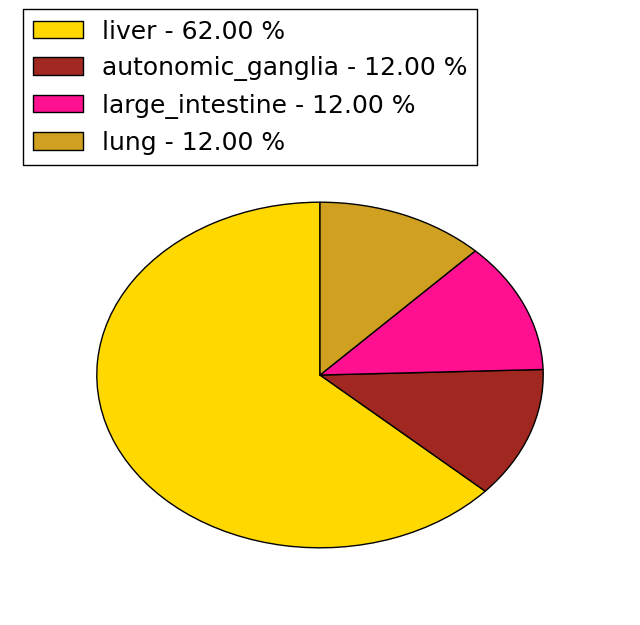 |  |
(# total SNVs=0) | (# total SNVs=0) |
| Top |
| * When you move the cursor on each content, you can see more deailed mutation information on the Tooltip. Those are primary_site,primary_histology,mutation(aa),pubmedID. |
| GRCh37 position | Mutation(aa) | Unique sampleID count |
| chr6:31765563-31765563 | p.R87G | 3 |
| chr6:31765565-31765565 | p.A86V | 2 |
| chr6:31765567-31765567 | p.A85A | 2 |
| chr6:31765628-31765628 | p.S65L | 1 |
| chr6:31765635-31765635 | p.R63W | 1 |
| chr6:31765646-31765646 | p.N59S | 1 |
| chr6:31766264-31766264 | p.S31F | 1 |
| chr6:31773857-31773857 | p.D22D | 1 |
| chr6:31773919-31773919 | p.L2V | 1 |
| chr6:31773924-31773924 | p.? | 1 |
| Top |
|
 |
| Point Mutation/ Tissue ID | 1 | 2 | 3 | 4 | 5 | 6 | 7 | 8 | 9 | 10 | 11 | 12 | 13 | 14 | 15 | 16 | 17 | 18 | 19 | 20 |
| # sample | 1 | 1 | 1 | 1 | 1 | |||||||||||||||
| # mutation | 1 | 1 | 1 | 1 | 1 | |||||||||||||||
| nonsynonymous SNV | 1 | 1 | 1 | 1 | ||||||||||||||||
| synonymous SNV | 1 |
| cf) Tissue ID; Tissue type (1; BLCA[Bladder Urothelial Carcinoma], 2; BRCA[Breast invasive carcinoma], 3; CESC[Cervical squamous cell carcinoma and endocervical adenocarcinoma], 4; COAD[Colon adenocarcinoma], 5; GBM[Glioblastoma multiforme], 6; Glioma Low Grade, 7; HNSC[Head and Neck squamous cell carcinoma], 8; KICH[Kidney Chromophobe], 9; KIRC[Kidney renal clear cell carcinoma], 10; KIRP[Kidney renal papillary cell carcinoma], 11; LAML[Acute Myeloid Leukemia], 12; LUAD[Lung adenocarcinoma], 13; LUSC[Lung squamous cell carcinoma], 14; OV[Ovarian serous cystadenocarcinoma ], 15; PAAD[Pancreatic adenocarcinoma], 16; PRAD[Prostate adenocarcinoma], 17; SKCM[Skin Cutaneous Melanoma], 18:STAD[Stomach adenocarcinoma], 19:THCA[Thyroid carcinoma], 20:UCEC[Uterine Corpus Endometrial Carcinoma]) |
| Top |
| * We represented just top 10 SNVs. When you move the cursor on each content, you can see more deailed mutation information on the Tooltip. Those are primary_site, primary_histology, mutation(aa), pubmedID. |
| Genomic Position | Mutation(aa) | Unique sampleID count |
| chr6:31765774 | p.Y69Y | 1 |
| chr6:31766264 | p.S56L | 1 |
| chr6:31773919 | p.P52H | 1 |
| chr6:31765615 | p.S31F | 1 |
| chr6:31765655 | p.L2V | 1 |
| * Copy number data were extracted from TCGA using R package TCGA-Assembler. The URLs of all public data files on TCGA DCC data server were gathered on Jan-05-2015. Function ProcessCNAData in TCGA-Assembler package was used to obtain gene-level copy number value which is calculated as the average copy number of the genomic region of a gene. |
 |
| cf) Tissue ID[Tissue type]: BLCA[Bladder Urothelial Carcinoma], BRCA[Breast invasive carcinoma], CESC[Cervical squamous cell carcinoma and endocervical adenocarcinoma], COAD[Colon adenocarcinoma], GBM[Glioblastoma multiforme], Glioma Low Grade, HNSC[Head and Neck squamous cell carcinoma], KICH[Kidney Chromophobe], KIRC[Kidney renal clear cell carcinoma], KIRP[Kidney renal papillary cell carcinoma], LAML[Acute Myeloid Leukemia], LUAD[Lung adenocarcinoma], LUSC[Lung squamous cell carcinoma], OV[Ovarian serous cystadenocarcinoma ], PAAD[Pancreatic adenocarcinoma], PRAD[Prostate adenocarcinoma], SKCM[Skin Cutaneous Melanoma], STAD[Stomach adenocarcinoma], THCA[Thyroid carcinoma], UCEC[Uterine Corpus Endometrial Carcinoma] |
| Top |
| Gene Expression for LSM2 |
| * CCLE gene expression data were extracted from CCLE_Expression_Entrez_2012-10-18.res: Gene-centric RMA-normalized mRNA expression data. |
 |
| * Normalized gene expression data of RNASeqV2 was extracted from TCGA using R package TCGA-Assembler. The URLs of all public data files on TCGA DCC data server were gathered at Jan-05-2015. Only eight cancer types have enough normal control samples for differential expression analysis. (t test, adjusted p<0.05 (using Benjamini-Hochberg FDR)) |
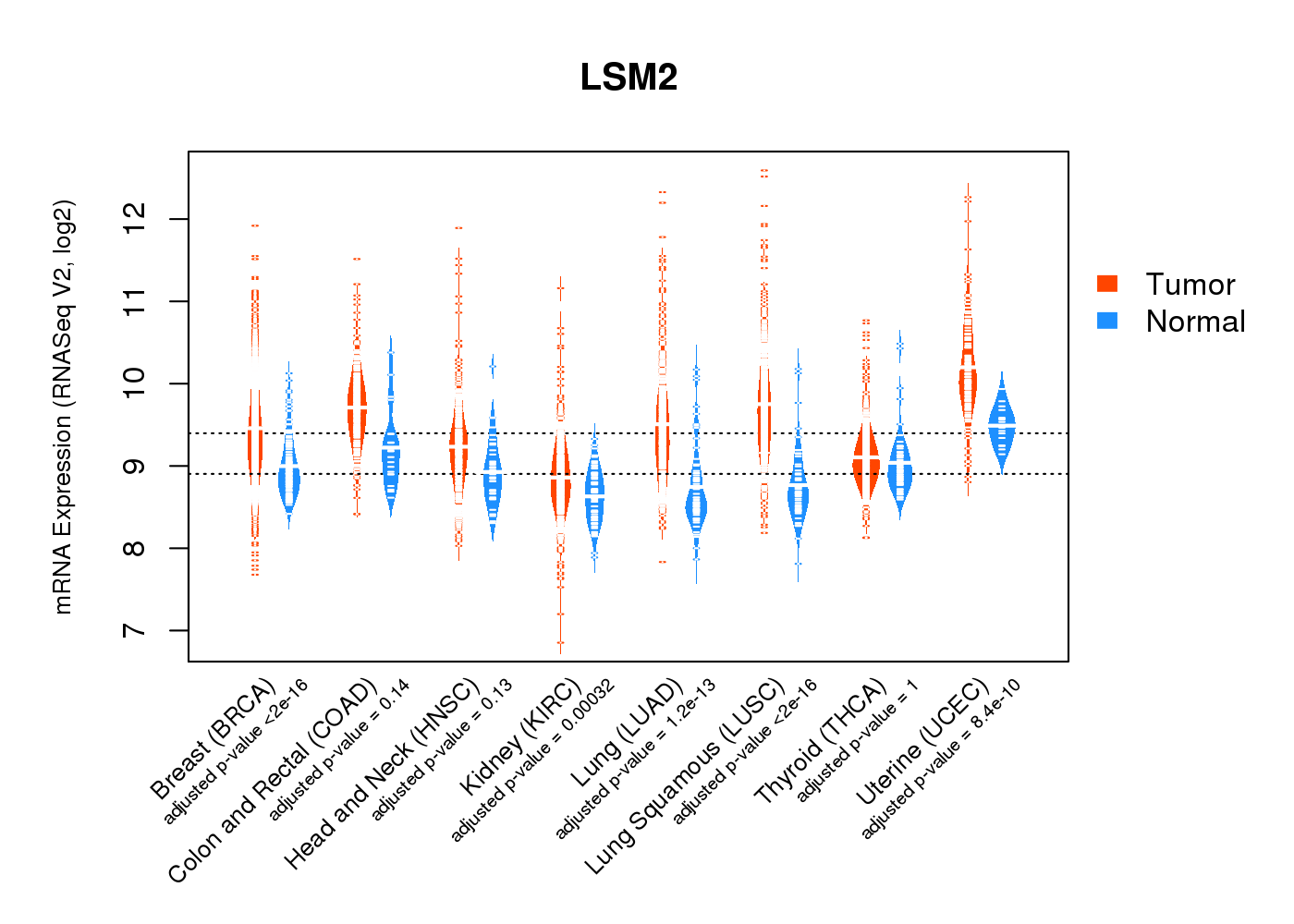 |
| Top |
| * This plots show the correlation between CNV and gene expression. |
: Open all plots for all cancer types
 |
|
 |
|
| Top |
| Gene-Gene Network Information |
| * Co-Expression network figures were drawn using R package igraph. Only the top 20 genes with the highest correlations were shown. Red circle: input gene, orange circle: cell metabolism gene, sky circle: other gene |
: Open all plots for all cancer types
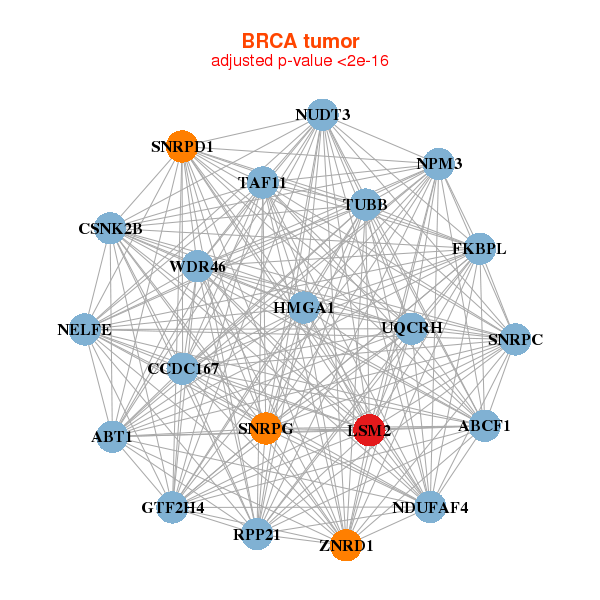 |
| ||||
| ABCF1,ABT1,CCDC167,CSNK2B,FKBPL,GTF2H4,HMGA1, LSM2,NDUFAF4,NPM3,NUDT3,NELFE,RPP21,SNRPC, SNRPD1,SNRPG,TAF11,TUBB,UQCRH,WDR46,ZNRD1 | C17orf49,CSNK2B,CUTA,DGUOK,DPM2,DYRK4,LSM2, PDCD6,PFDN5,POLR2G,PPIA,PPIH,RPL27A,RPS24, SF3B14,SNRPD2,SNRPF,SSR2,SUPT4H1,UBE2I,UXT | ||||
 |
| ||||
| CKS2,COX7A2,GADD45GIP1,LSM2,LSM3,MRPL11,MRPL14, MRPL22,MRPL54,MYEOV2,NDUFA11,NDUFA13,PPIL1,RPL35, RPS10,RPS18,SF3B5,SRSF3,SNRPC,SNRPG,TIMM8B | ADSL,ELP6,TMEM261,GEMIN6,LSM2,MRPL11,MRPL49, MRPL52,MRPS14,MRPS15,MRPS7,NHP2,NUDCD2,POLE3, POLR2G,RPL35,RPSAP58,SNRPC,SNRPD2,STOML2,TOMM6 |
| * Co-Expression network figures were drawn using R package igraph. Only the top 20 genes with the highest correlations were shown. Red circle: input gene, orange circle: cell metabolism gene, sky circle: other gene |
: Open all plots for all cancer types
| Top |
: Open all interacting genes' information including KEGG pathway for all interacting genes from DAVID
| Top |
| Pharmacological Information for LSM2 |
| DB Category | DB Name | DB's ID and Url link |
| Organism-specific databases | PharmGKB | PA25929; -. |
| Organism-specific databases | CTD | 57819; -. |
| * Gene Centered Interaction Network. |
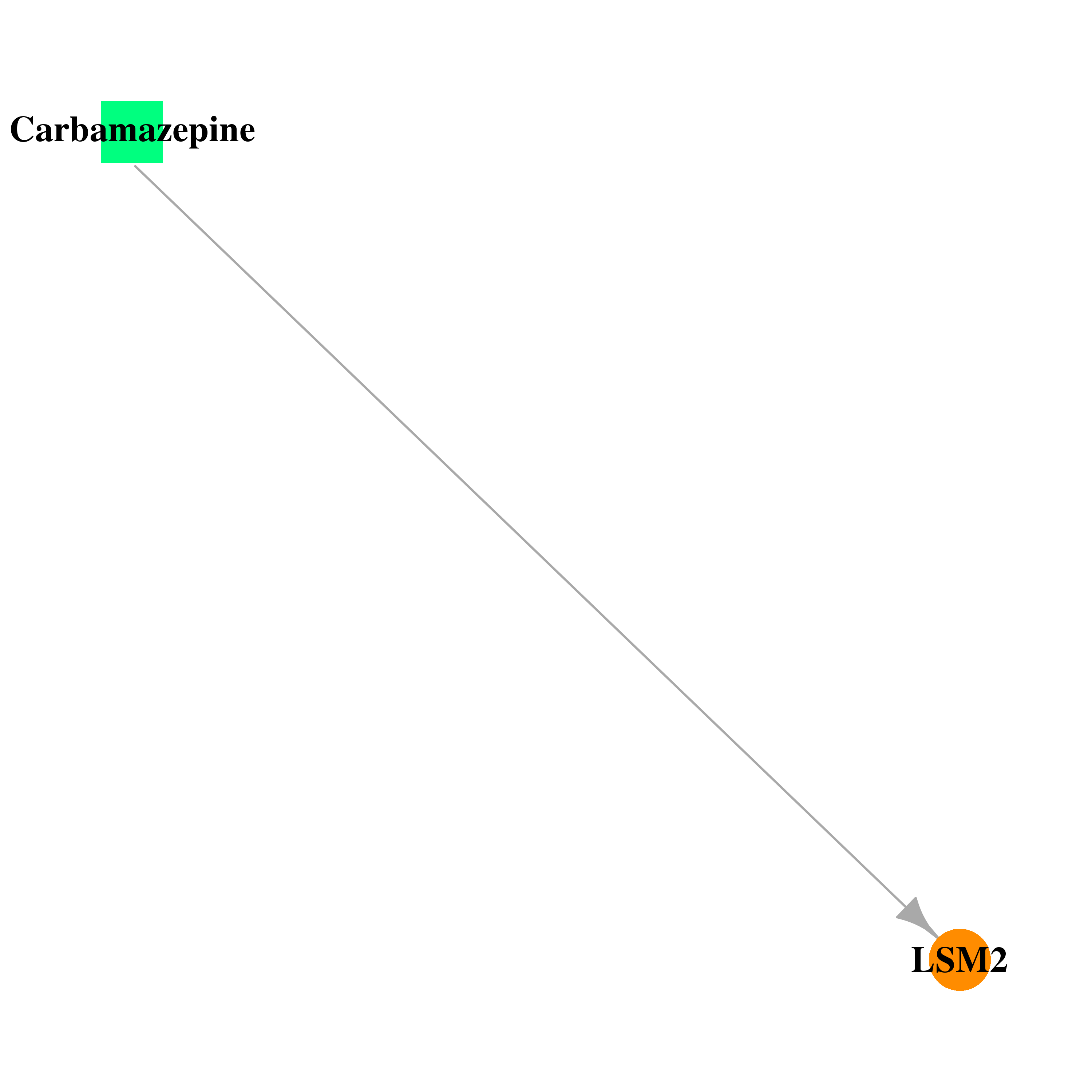 |
| * Drug Centered Interaction Network. |
| DrugBank ID | Target Name | Drug Groups | Generic Name | Drug Centered Network | Drug Structure |
| DB00564 | LSM2 homolog, U6 small nuclear RNA associated (S. cerevisiae) | approved; investigational | Carbamazepine | 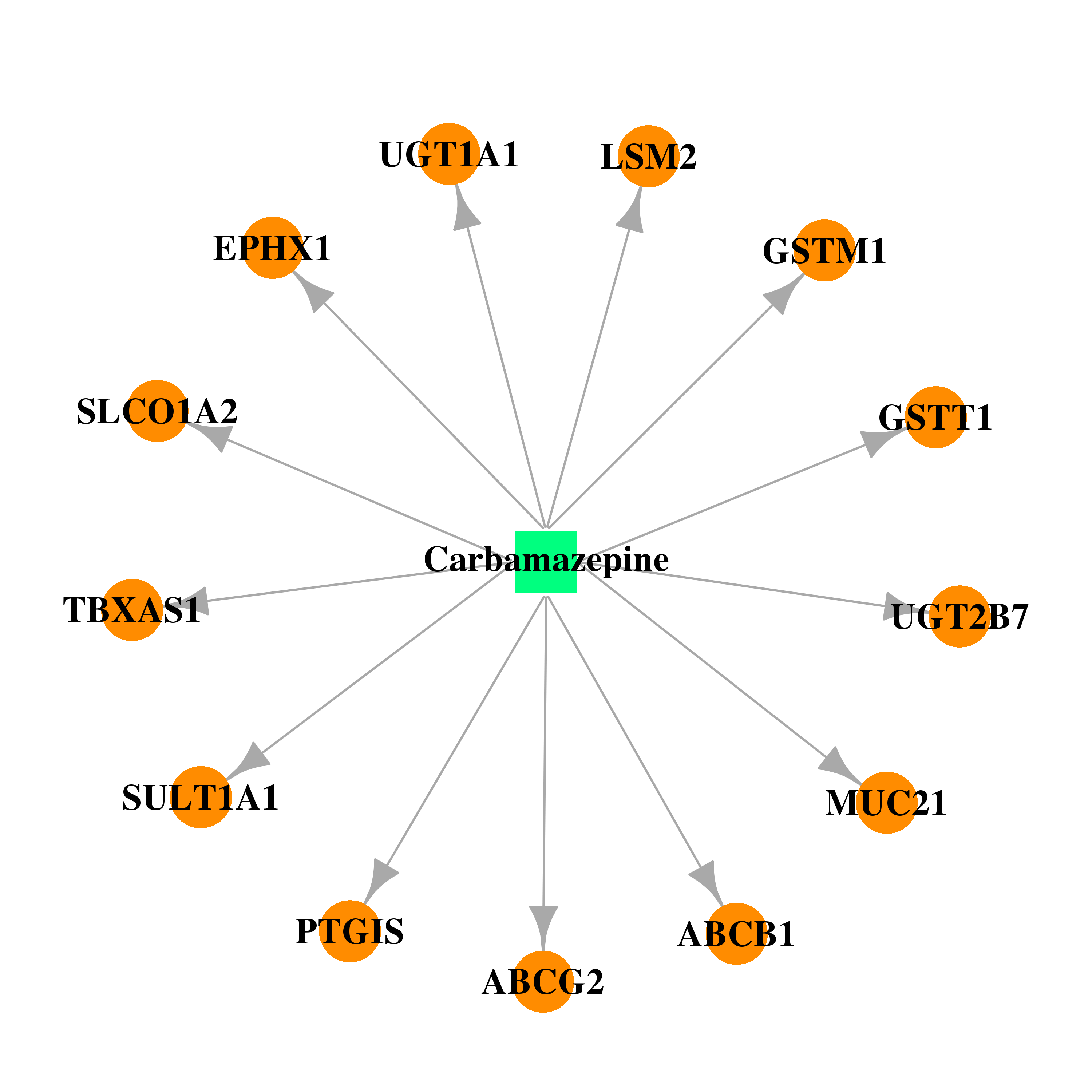 | 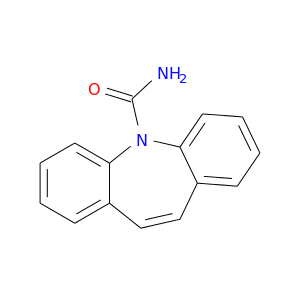 |
| Top |
| Cross referenced IDs for LSM2 |
| * We obtained these cross-references from Uniprot database. It covers 150 different DBs, 18 categories. http://www.uniprot.org/help/cross_references_section |
: Open all cross reference information
|
Copyright © 2016-Present - The Univsersity of Texas Health Science Center at Houston @ |







